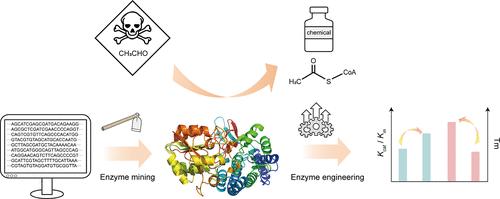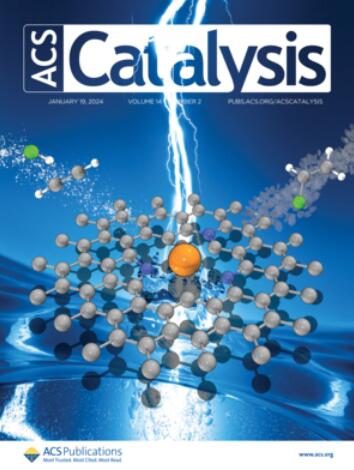Simultaneous Engineering of the Thermostability and Activity of a Novel Aldehyde Dehydrogenase
IF 11.3
1区 化学
Q1 CHEMISTRY, PHYSICAL
引用次数: 0
Abstract
Acetaldehyde is a toxic pollutant that can be detoxified by acetaldehyde dehydrogenases (ADAs) through its conversion to acetyl-CoA. This study developed an integrated approach combining virtual screening, rational design, and a dual scoring mechanism to identify and engineer hyperactive ADA variants. A library of 5000 Dickeya parazeae ADA (DpADA) homologues was created through protein BLAST, and deep learning tools predicted their Kcat values. The top 100 candidates were selected based on acetaldehyde binding affinity, evaluated through molecular docking and phylogenetic analysis. Among these, ADA6 from Buttiauxella sp. S04-F03 exhibited the highest activity, converting 57.6% of acetaldehyde to acetyl-CoA, which was 14.1 times higher than DpADA. To improve ADA6’s thermostability, folding engineering was applied, resulting in the P443C variant with an 80.7% increase in residual activity after heat treatment. Molecular dynamics simulation pinpointed I440 as a bottleneck in the substrate tunnel, guiding the design of a dual-scoring system that integrates structural adjustments and electronic optimization to evaluate mutations for improved substrate exposure and activity. The final optimized variant, P443C-I440T, achieved a conversion efficiency of 93.2%. This study demonstrates the effectiveness of combining computational tools and rational mutagenesis to enhance enzyme activity and stability in enzyme engineering.

一种新型醛脱氢酶热稳定性和活性的同步工程研究
乙醛是一种有毒污染物,可以通过乙醛脱氢酶(ADAs)将其转化为乙酰辅酶a来解毒。本研究开发了一种结合虚拟筛选、合理设计和双重评分机制的综合方法,以识别和设计多动症ADA变体。通过蛋白BLAST建立了5000个Dickeya parazeae ADA (DpADA)同源物文库,并利用深度学习工具预测了它们的Kcat值。通过分子对接和系统发育分析,根据乙醛结合亲和力筛选出前100名候选物。其中,来自Buttiauxella sp. S04-F03的ADA6活性最高,将57.6%的乙醛转化为乙酰辅酶a,是DpADA的14.1倍。为了提高ADA6的热稳定性,采用了折叠工程,得到了P443C变体,热处理后残余活性提高了80.7%。分子动力学模拟将I440确定为底物通道中的瓶颈,指导双评分系统的设计,该系统集成了结构调整和电子优化,以评估改善底物暴露和活性的突变。最终的优化改型P443C-I440T实现了93.2%的转换效率。该研究表明,在酶工程中,将计算工具与合理诱变相结合可以有效地提高酶的活性和稳定性。
本文章由计算机程序翻译,如有差异,请以英文原文为准。
求助全文
约1分钟内获得全文
求助全文
来源期刊

ACS Catalysis
CHEMISTRY, PHYSICAL-
CiteScore
20.80
自引率
6.20%
发文量
1253
审稿时长
1.5 months
期刊介绍:
ACS Catalysis is an esteemed journal that publishes original research in the fields of heterogeneous catalysis, molecular catalysis, and biocatalysis. It offers broad coverage across diverse areas such as life sciences, organometallics and synthesis, photochemistry and electrochemistry, drug discovery and synthesis, materials science, environmental protection, polymer discovery and synthesis, and energy and fuels.
The scope of the journal is to showcase innovative work in various aspects of catalysis. This includes new reactions and novel synthetic approaches utilizing known catalysts, the discovery or modification of new catalysts, elucidation of catalytic mechanisms through cutting-edge investigations, practical enhancements of existing processes, as well as conceptual advances in the field. Contributions to ACS Catalysis can encompass both experimental and theoretical research focused on catalytic molecules, macromolecules, and materials that exhibit catalytic turnover.
 求助内容:
求助内容: 应助结果提醒方式:
应助结果提醒方式:


